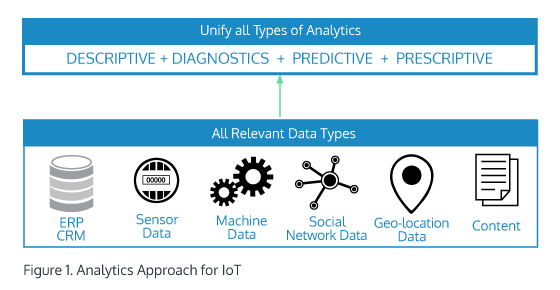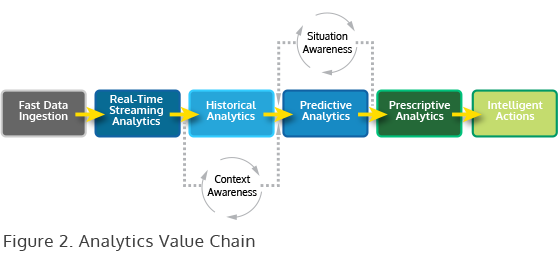The Analytics Value Chain –The Key to Delivering Value in IoT?
这是1末尾有html的
In our last blog, “Can a Traditional Analytics Approach Empower Business Operations In The IoT?” we asked if a traditional analytics approach is capable of supporting business operation for the Internet of Things (IoT).
Our conclusion, based on customer requirements, was that traditional approaches are not sufficient and that new approaches are needed to handle the time critical nature of IoT challenges
The Foundational Steps to Designing a New IoT Analytics Approach
The first step in designing a new approach is to simplify the process by integrating all the data for an IoT application. That includes all the structured, unstructured, and semi-structured datain your organization.
This range of data must be integrated for the analytics that will be run on the data. Better business outcomes are achieved when traditional silos are removed and analytics are used across a broad spectrum of valuable data.
The second key step in the streamlining process is to unify the analytics layer. In the traditional model, descriptive and diagnostic analytics made the problem challenging because of the “siloed” approach to data access.
The problem is more acute and unworkable for IoT applications. This traditional approach will not work for IoT because it will take significant time and effort for data management vs. focusing on delivering outcomes based on the analytics. The explosion of data in all forms in IoT requires a more robust and broader lens to enable smarter timely actions and better outcomes.
All the types of analytics must be unified into a single engine (as shown in Figure 1 below) to ensure scalability and real-time performance.

This includes historical analytics (descriptive & diagnostic), real-time streaming analytics, predictive analytics, and prescriptive analytics.
The Linchpin – Analytics Value Chain
The approach to analytics outlined above is a good first step for IoT. However, it is the ability to execute analytics in real-time across the analytics value chain (streaming, historical, predictive, and prescriptive analytics) with relevant contextual and situational data that addresses the critical “last mile” for timely outcomes.
Then this must be combined with the ability to take the next best action in any particular scenario to create the greatest value. The increasing value chain depicted in Figure 2 below shows how each step in the process refines the data and adds more value and context.

- Ingesting data at speed and volume sets the stage for additional processing
- Real-time Streaming Analytics processes incoming streams of data from IoT sensors and devices.
- This refined data is then correlated with contextual and historical data to provide a baseline for advanced analytics. Contextual data can include information like GIS (geographic information systems) data relating to an IoT application.
- The next step is to predict failures, anomalies, or patterns using predictive analytics that are based on machine learning over historical and situational data such as external events like weather.
- The final step in the analytics value chain is to apply prescriptive analytics to determine the next best action to take. This next best action could be a wide variety of actions associated with lowering risks, addressing an outage, or making a real-time offer to a customer to capture a sales opportunity in retail.
The important point is that specific actions based on a rich understanding of history and context must be taken NOW in order to capture that value. New tools are needed to achieve this ambitious goal for IoT. This approach towards faster analytics across the analytics value chain could be the linchpin to create the greatest value in IoT.
Download the White Paper to Learn More
Get the white paper to learn more about the Analytics Value Chain approach to IoT analytics and its use cases in Manufacturing, Utilities, and Telecommunications.
